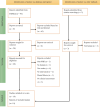A systematic review of alterations in brain activation and intensity following stroke: implications for integration and functional outcomes
- PMID: 40492169
- PMCID: PMC12146161
- DOI: 10.3389/fneur.2025.1544008
A systematic review of alterations in brain activation and intensity following stroke: implications for integration and functional outcomes
Abstract
Background: Stroke remains a leading cause of disability, making it critical to understand the underlying neurophysiological mechanisms for effective rehabilitation. Task-based functional Magnetic Resonance Imaging (fMRI) provides valuable insights into brain activation patterns; however, its correlation with clinical evaluations is not yet fully understood. This systematic review aims to explore the relationship between task-based fMRI findings and clinical assessments in stroke patients, comparing them to healthy controls.
Methods: Using the PubMed database and adhering to PRISMA guidelines, we identified and analyzed 11 eligible studies. Total participant is 323 participant with 258 of them is stroke patients and 65 is HC.
Results: Results reveal significant differences in brain activation patterns between stroke patients and healthy controls, with stroke patients displaying compensatory hyperactivation in certain brain regions such as cerebellum, inferior parietal cortex, and contralesional area. Additionally, longitudinal comparisons among stroke patients show notable improvements in activation patterns from baseline to the subacute and chronic stages following rehabilitation. These changes align with enhanced clinical outcomes, suggesting that fMRI may serve as a sensitive biomarker for recovery progress. Importantly, correlations between fMRI results and clinical scores highlight the potential of task-based fMRI to inform and refine rehabilitation strategies.
Conclusion: This review underscores the value of integrating fMRI findings into clinical practice to better understand stroke recovery mechanisms. Further research is needed to deepen our understanding of these associations and optimize patient outcomes in stroke rehabilitation.
Keywords: based functional magnetic resonance imaging; brain activity; compensation; hemorrhage stroke; ischemic stroke; neurorehabilitation; rehabilitation.
Copyright © 2025 Azri, Yahya, Nabilah Ismail, Ashari and Abdul Manan.
Conflict of interest statement
The authors declare that the research was conducted in the absence of any commercial or financial relationships that could be construed as a potential conflict of interest.
Figures
Similar articles
-
Patterns of Visual Task-based Functional MRI Activation in Chronic Posterior Cerebral Artery Stroke Patients.Clin Neuroradiol. 2023 Sep;33(3):769-781. doi: 10.1007/s00062-023-01274-2. Epub 2023 Mar 3. Clin Neuroradiol. 2023. PMID: 36867244 Free PMC article.
-
Parietal operculum and motor cortex activities predict motor recovery in moderate to severe stroke.Neuroimage Clin. 2017 Jan 26;14:518-529. doi: 10.1016/j.nicl.2017.01.023. eCollection 2017. Neuroimage Clin. 2017. PMID: 28317947 Free PMC article.
-
Neural correlates of proprioceptive integration in the contralesional hemisphere of very impaired patients shortly after a subcortical stroke: an FMRI study.Neurorehabil Neural Repair. 2008 Mar-Apr;22(2):154-65. doi: 10.1177/1545968307307118. Epub 2007 Oct 4. Neurorehabil Neural Repair. 2008. PMID: 17916656
-
The role of the contralesional primary motor cortex in upper limb recovery after stroke: a scoping review following PRISMA-ScR guidelines.BMC Neurosci. 2025 May 25;26(1):31. doi: 10.1186/s12868-025-00950-y. BMC Neurosci. 2025. PMID: 40414854 Free PMC article.
-
Integrated technology for evaluation of brain function and neural plasticity.Phys Med Rehabil Clin N Am. 2004 Feb;15(1):263-306. doi: 10.1016/s1047-9651(03)00124-4. Phys Med Rehabil Clin N Am. 2004. PMID: 15029909 Review.
References
-
- Choi EY, Nieves GA, Jones DE. Acute Stroke Diagnosis. Am Fam Physician. (2022) 105:616–24. PMID: - PubMed
Publication types
LinkOut - more resources
Full Text Sources


